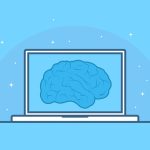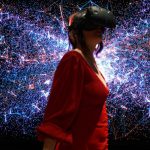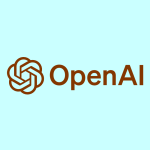Machine learning is an application of artificial intelligence (AI) that assists in predicting future outcomes. Machine learning is being used across many industries, from fraud detection to business process automation. Machine learning gives companies a different view of their operational patterns and trends in customer behavior.
The machine learning framework moves beyond the traditional model of computation. Instead of arriving at a definite reproducible answer through a series of calculations, machine learning — a branch of artificial intelligence — works on a series of statistical probabilities to suggest new solutions to a problem. This work is useful for such jobs as designing new materials, medical diagnosis, advanced game graphics and so many other tasks.
What Is Machine Learning?
Machine learning (ML) is part of artificial intelligence (AI) which assists various applications in predicting futuristic outcomes more accurately. Machine learning is being used in many industries and for a variety of purposes from fraud detection to business process automation. Enterprises gain a different view of operational patterns within the organization and trends in customer behavior through machine learning implementation.
Machine Learning Techniques Are Used to Train Algorithms
There are four types of algorithms and several techniques used in machine learning. These types — supervised, unsupervised, semi-supervised, and reinforcement learning — and their respective techniques are examined below:
Supervised Machine Learning
Much of the early success in machine learning has come from supervised learning, where a clearly defined data set is already available for analysis. The algorithm then determines how to arrive at given outputs and inputs. The machine learning algorithm makes predictions by analyzing the data and is corrected by the operator until its predictions are highly accurate.
In supervised machine learning, the algorithm learns through these three techniques:
Classification. The machine learning program determines what categories new observations belong to based on the analysis and observation of the available data sets.
Regression. The machine learning program estimates the relationship between variables where there is one dependent variable and a number of changing variables.
Forecasting. This involves making predictions about the future from new and existing data. It is also used to analyze trends.
Gathering recent momentum has been the Deep Learning technique, which doesn’t require all the intermediate steps that supervised learning does. Instead, the idea is to let the Deep Learning neural nets find the answers on their own.
Machine learning can be used for many different applications and industries, including operations. Find out more about Machine Learning for Operations.
Semi-Supervised Learning
Machine learning algorithms are provided with labeled and unlabeled data. Labeled data provides information about a given data set that helps the algorithm understand what the data is about. Unlabeled data has no descriptions. Through semi-supervised learning, machine learning algorithms learn to label unlabeled data.
Unsupervised Machine Learning
In an unsupervised learning process, the machine learning program is left to observe and analyze large data sets by determining the relationship between variables. There is no operator to make corrections and the algorithm solely addresses data accordingly. As it assesses more data sets, its deductions improve and become refined.
In unsupervised machine learning, the algorithm learns through these techniques:
Clustering. Based on defined criteria, the machine learning program groups similar data from a set by finding a pattern. Clustering is done when each data group needs to be segmented and analyzed.
Dimension reduction. Through predetermined criteria, this process reduces the number of available variables to find the required information.
Reinforcement Machine Learning
In reinforcement machine learning, algorithms are given specific actions, parameters, and results. The algorithm determines the rules and develops different processes for arriving at the given conclusion. The machine learning algorithm arrives at the result through trial and error. Through reinforcement, algorithms learn based on past experiences and adopt the optimal approach determined in new situations.
Top Machine Learning Technologies Are Transforming Ideas
Artificial intelligence technologies are improving outputs in machine learning. Through technology, operators can develop automated machine learning algorithms and achieve more in less time. Some new technologies train machine learning models and others such as Google’s Auto ML Zero — a new kind of automated machine learning — use simple methods to create algorithms that can be adapted to a task at hand.
RapidMiner: an automated ML tool that can significantly reduce the time needed to create predictive models for businesses across many industries with various resources and sizes.
Big ML: technology that automates the machine learning pipeline.
DataRobot: an automated ML tool leveraging regression techniques, neural networks, and gradient boosting to solve multi-class classification problems.
Auto Keras: an open-source software library designed to improve the creation of deep learning techniques
H20: technology that uses its own algorithms to create and optimize pipelines. This is achieved through exhaustive search.
TPOT: AI technology that uses genetic algorithms to optimize machine learning pipelines.
TensorFlow: an open source machine learning framework created by Google that is easy to deploy across various platforms.
Scikit-learn: an open source library developed for machine learning featuring several ML techniques.
Machine Learning Use Cases Are Expanding
Machine learning has many potential applications and is growing rapidly. The exponential growth of data contributes to the expansion and use of machine learning. Not only can machine learning be applied to client-facing applications like product recommendation, customer service, and forecasts, but it can also be used by internal teams to speed up processes and time-consuming tasks.
Here are some machine learning use cases today:
- Fraud detection
- Dynamic pricing
- Product recommendation
- Email filtering
- Personalized marketing
- Process automation
- Improving sustainability and the environment
- Proactive help desk operations
At The New Stack, we have focused our coverage of this emerging field mostly around two areas of scalable architecture. We are keeping a close eye on the emerging field of AIOps, where machine learning can influence and drive IT operations. AIOps help to automate the path from development to production, predicting the effect of deployment on production and automatically responding to changes in how the production environment is performing. Companies such as New Relic, OpsRamp, and Moogsoft have all invested heavily in this area.
Another area of machine learning we are covering closely is how Kubernetes and related cloud native technologies can expedite the machine learning lifecycle. Machine learning involves an entire IT cycle of technologies that are very early on in terms of commercialization. Data must be harvested and cleansed, models must be tested, and the most useful approaches must be pressed into production, with a feedback loop of some sort to ensure the models can be updated. Emerging workflows such as Kubeflow and Anaconda can help streamline these processes.














